Back to Journals » Patient Preference and Adherence » Volume 15
Patients Satisfaction and Associated Factors Towards Physiotherapy Services in North West Ethiopia
Authors Endawoke M , Alem G , Mulugeta H , Atinafu BT , Nigussie F , Simachew A , Shimekaw A , Abiye M
Received 2 September 2021
Accepted for publication 22 November 2021
Published 14 December 2021 Volume 2021:15 Pages 2783—2791
DOI https://doi.org/10.2147/PPA.S337443
Checked for plagiarism Yes
Review by Single anonymous peer review
Peer reviewer comments 4
Editor who approved publication: Dr Johnny Chen
Migbaru Endawoke,1 Girma Alem,2 Henok Mulugeta,2 Bantalem Tilaye Atinafu,3 Fetene Nigussie,3 Addisu Simachew,4 Atirsaw Shimekaw,1 Melese Abiye5
1Department of Nursing, Dilla University College of Health Science and Medicine, Addis Ababa, Dilla, Ethiopia; 2Department of Nursing, Debre Markos University College of Health Science, Addis Ababa, Debre Markos, Ethiopia; 3Department of Nursing, Debre Berhan University Institute of Medicine and College of Health Science, Addis Ababa, Debre Berhan, Ethiopia; 4Department of Nursing, Dimma Technology College, Addis Ababa, Debre Markos, Ethiopia; 5Department of Nursing, Ambo University College of Medicine and Health Science, Addis Ababa, Ambo, Ethiopia
Correspondence: Migbaru Endawoke Tel +251 915715186
Email [email protected]
Background: Patient satisfaction is a critical patient-focused indicator of the general quality of patient care and health care. There was only one previous study conducted to assess patient satisfaction with physiotherapy services in Ethiopia.
Objective: This study aimed to assess patients’ satisfaction and associated factors towards physiotherapy services in North West Ethiopia.
Methods: An institution-based cross-sectional study was conducted. Using consecutive sampling method, 393 samples were collected. The collected data were cleaned, coded, entered into Epi-Data version 4.2 and exported to SPSS version 25 for analysis. The binary logistic regression model was fitted and p-value less than 0.25 was used to select significant variables for multivariate analysis. Results were presented in frequency distribution tables and graphs.
Results: Overall 201 (51.1%) of the respondents were satisfied. The odds of physiotherapy service satisfaction at age greater than 55 years old were OR 1.78 (95% CI: 1.02– 3.09) times higher than the age less than or equal to 55 years old. The odds of physiotherapy service satisfaction of married respondents were OR 1.75 (95% CI: 1.05– 2.90) times higher than for single patients and the odds of satisfaction of having a good feeling about physiotherapy service was OR 3.76 (95% CI: 1.46– 9.70) times higher than their counterparts.
Conclusion: Almost half of the respondents were satisfied with the physiotherapy service. Age, marital status, history of having information about physiotherapy and feelings about the physiotherapy service were significant variables affecting patient’s satisfaction in the physiotherapy service.
Keywords: patient satisfaction, physiotherapy, Northwest Ethiopia
Background
Patient satisfaction is an essential marker of the quality of healthcare service. It is the degree to which a patient feels that their needs and point of view have been met on behalf of their everyday expenditure made to get quality health-care services.1,2 Patients who are satisfied with the quality of health care are more likely to adhere to a treatment plan, seek medical consultation in the hospital, maintain a continuous relationship with the hospital, recommend the hospital to others in the community, make informed choices about the health-care providers, offer feedback and encourage a continuous quality improvement in the hospital.3–5
Physiotherapy is a health-care profession primarily focused on the management of impairments and disabilities and the promotion of functional ability, mobility, quality of life and movement potential through examination, evaluation, diagnosis and physical intervention.6,7 Physiotherapy helps to reduce pain, improve joint mobility and strength, restore physical functioning and prevent injury, prevent or delay surgery, improve balance, coordination, strength, flexibility and function, and restore the aptitude to survive daily tasks. Physically, intellectually, or emotionally disabled individuals cover a significant portion of the world population.8
Greater than one billion people in the world live with some form of disability, from those nearly 200 million experience considerable difficulties in functioning. It will be a more significant concern because its prevalence is on the rise due to aging populations and the higher risk of disability in older people as well as an international increase in chronic health conditions.8 Satisfaction with treatment effect is important to distinguish from satisfaction without treatment delivery, as those who are satisfied due to an improvement from their illness would be less likely to seek additional treatment, or tend to suggest the services of those organizations to other people.6
Globally, physical therapy has been a low priority for many governments, especially those with limited health investment, which has resulted in under-developed, poorly coordinated services.8 In the last decade, there has been an increase in patient satisfaction studies seeking to assess the quality of care from the patient’s own perspective.9–11 These satisfaction studies were mainly done in western countries and among patients with musculoskeletal disorders. While health-care services in developed countries have utilized the health outcomes associated with patient satisfaction the use of patient satisfaction to inform care practices is evolving in developing nations.3 Several studies conducted in southern Africa indicate a significant gap between the requirement for rehabilitation and its response with an increase in aging populations, the rising prevalence of non-communicable diseases and the increasing numbers of people living with the consequences of injury.12 Many countries in Sub-Saharan Africa (SSA) contend with a shortage of rehabilitation workers, including physiotherapists. It is difficult to accurately quantify the unmet need for physiotherapists in the Sub-Saharan African region.13,14
The number of persons with disabilities in Ethiopia is likely to be underestimated due to inadequate definitions of what constitutes a disability and which disabilities should be included in the count.6 Based on the World Report, there are an estimated 15 million children, adults and elderly persons with disabilities in Ethiopia, representing 17.6% of the population where the physiotherapeutic measures are helping to solve the challenge.6 The International Committee of the Red Cross in Ethiopia continues to cooperate closely with the ministry of social affairs and with its regional offices to promote long-term functioning of the physical rehabilitation sector.15
Studies on the experience of physiotherapy care and on patient satisfaction with their associated factors among patients in Ethiopia is scarce.14 Many studies were mainly focused on assessing patient satisfaction at a hospital or facility level and not at a unit level. As far as our search indicates, only one previous study was done in Ethiopia about patient satisfaction towards physiotherapy services. But this study which was conducted before in Ethiopia, excluded individuals who cannot read and write the national language of Ethiopia from participating in the study.6 This study will fill the gap of the previous study and will help the physiotherapists investigate the extent to which their services have been able to meet the needs of their clients/patients or not and will promote health education and research on health-related problems. Therefore this study is aimed to assess patients’ satisfaction towards physiotherapy services and identify associated factors affecting patient satisfaction on physiotherapy service in North West, Ethiopia from April 26 to May 26, 2021.
Objectives
General Objective
To assess patients’ satisfaction and associated factors towards physiotherapy services, North West Ethiopia.
Specific Objectives
- To determine patients’ satisfaction towards physiotherapy services, North West Ethiopia.
- To identify factors associated with patient satisfaction on physiotherapy services, North West Ethiopia.
Methods and Materials
Study Design
An institution-based cross-sectional study was conducted.
Study Area and Period
The study was conducted in Debre Markos and Felege Hiwot Comprehensive Specialized Hospitals, North West Ethiopia. Debre Markos Comprehensive Specialized Hospital is found in East Gojjam Zone Debre Markos town, 300 km away from Addis Ababa, North West Ethiopia and 265 km from Bihar Dar, the capital city of Amhara regional state. Felege Hiwot Comprehensive Specialized Hospital is found in Bahir Dar, the capital city of the Amhara region, 565 km North West of Addis Ababa, Ethiopia. Physiotherapy outpatients provides a service for about 200 patients per month with two physiotherapists in DMCSH and for about 900 patients in FHCSH. The study was conducted from April 26to May 26, 2021.
Population and Inclusion Criteria/Exclusion Criteria
The source population of this study was all patients visiting the physiotherapy unit of Debre Markos and Felege Hiwot Comprehensive Specialized Hospital and the study population was all adult patients who had at least three physiotherapy care sessions in the center at Debre Markos and Felege Hiwot Comprehensive Specialized Hospital and were available during the data collection period. All adult patients who had at least three physiotherapy care sessions at DMCSH and FHCSH were included and patients who have difficulties in talking and unable to respond for an interview because of their illness (one patient were excluded because of talking difficulties) were excluded.
Sample Size Determination and Procedure
Sample size was calculated by using a single population proportion formula with the following assumptions: n = required sample size, Z = critical value for normal distribution at 95% confidence level (1.96), d = 0.05 (5% margin of error), P = 54.4% (6) and an estimated non-response rate of 10%. The required sample size was:
 = (1.96)2 × (0.54 × 0.46)/(0.05)2 = 382 and adding 10% non-response rate gives final sample size of 420.
= (1.96)2 × (0.54 × 0.46)/(0.05)2 = 382 and adding 10% non-response rate gives final sample size of 420.
Using a proportional sampling method, 344 samples from Felege Hiwot and 76 from Debre Markos Comprehensive Specialized hospital were included.
Study Variables
The dependent variables were patient satisfaction (satisfied/dissatisfied). The independent variables were age, sex, residence, marital status, educational status, occupation, history of hearing about physiotherapy service, presence of supporting family, feeling towards physiotherapy, discontinuation of physiotherapy service, reason of follow up, and duration of follow up.
Data Collection Tool
The MedRisk patient satisfaction (MRPS) tool contains a total of 27 items. It was validated and its reliability was checked using Cronbach’s alpha having the value of 0.813. The items had patient-related factors, physiotherapist-related factors, and physiotherapy service-related factors and organizational factors.
Data extraction tool was adopted from different articles that scores from 1 to 5 (higher values indicate higher satisfaction) for each item.6,16 Items are presented in the form of statements written in a positive or negative direction and respondents score using a 1–5 Likert scale (“strongly satisfied”, “satisfied”, “uncertain”, “dissatisfied”, “strongly dissatisfied”). The tool had 27 items with a lowest value of 1 and highest value of 5 for each. The median of the total scores of the tool estimated the overall satisfaction of the respondents to physiotherapy service. Value of median and below is considered as dissatisfied and above the median value as satisfied (which is 106).17
Operational and Term Definitions
Patients are considered satisfied when total satisfaction score is greater than the median value (106)17 and dissatisfied when total satisfaction score of MRPS tool is less than or equal to the median value (106).
Data Collection Procedures
First, the questionnaire was prepared in English and translated to Amharic, then back to English to check for its consistency. Data were collected by the consecutive sampling method. The relevant data involving socio-demographic data, physiotherapy service-related data, organization and physiotherapist-related data were collected from patients attending the physiotherapy services in Debre Markos and Felege Hiwot Comprehensive Specialized Hospital.
Data Quality Assurances
Training about data collection was given for data collectors for one day before data collection. Pre-test was done on 5% of the participants at Tibebe Gion Specialized Hospital. Cronbach’s alpha was computed from data of the pre-test to determine the internal consistency of responses and revealed experts on the field had a score of 0.813 and face validity. Close monitoring and evaluation was done by the principal investigator in every aspect of the review. The principal investigator did a random evaluation assessment of the collected data for its completeness on a daily basis.
Data Processing and Analysis
Data were collected, cleaned, coded, entered into Epi-Data version 4.2 and exported to SPSS version 25 for analysis. The binary logistic regression model was fitted to identify factors associated with satisfaction. Bi-variate and multi-variate logistic regression were performed between dependent and independent variables and p-value less than 0.05 at 95% CI is used to declare association. Model fitness was checked using a Hosmer Lemeshow goodness of fitness test which estimated a p-value of 0.234. Median and inter-quartile range was assessed for continuous variables and frequency, and the percentage was calculated for categorical variables. Results were presented in frequency distribution tables and graphs.
Result
Socio-Demographic Characteristics of the Study Participants
A total of 393 participants were included in this study with a response rate of 93.6%. Two-thirds (66.9%) of the participants were male and the median age of the respondents was 39 ± 10.5 years. From the participants 125 (31.8%) were from the rural area and 254 (64.6%) were married. In terms of the educational status of the participants, 74 (18.8%) never attended school and 131 (33.3%) were civil servants (Table 1).
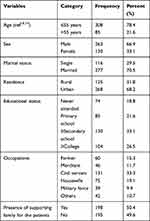 |
Table 1 Socio-Demographic Characteristics Related Results |
Patient-Related Results of the Respondents
The most common reason for follow up for physiotherapy service was musculoskeletal disorder 232 (59%). From those participants 269 (68.4%) did not hear about physiotherapy care before getting the service, 367 (93.4%) have good feeling about physiotherapy care and from those who were attended physiotherapy care only 69 (17.6%) had a history of service discontinuation (Table 2).
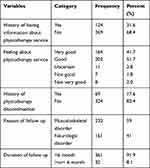 |
Table 2 Patient-Related Results |
In this study, 251 (63.9%) of the respondents were very satisfied with the physiotherapists being respectful, 198 (50.4%) with the physiotherapist able to give enough time for treatment and about 271 (69%) with the physiotherapist being friendly and courteous (Table 3).
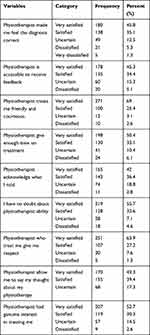 |
Table 3 Physiotherapists-Related Patient Satisfaction |
Physiotherapy Service-Related Patient’s Satisfaction
In this study, about 289 (73.6%) of the respondents were very satisfied with the improvement of their complaints after having treatment, and about 326 (83%) of the respondents were satisfied or very satisfied overall with the physiotherapy care given at the center (Table 4).
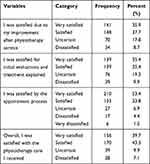 |
Table 4 Physiotherapy Service-Related Patient’s Satisfaction |
Organization-Related Patient Satisfactions
In this study, under half of the respondents, 144 (36.6%) were satisfied with the materials and equipment available in the center. About 326 (83%) respondents were satisfied with not waiting for long before being attended by the physiotherapists. The median score of satisfaction and inter-quartile range of the respondent was 106 ± 14, and as a whole, 201 (51.1%) of the respondent were satisfied with physiotherapy care given in the center (Table 5).
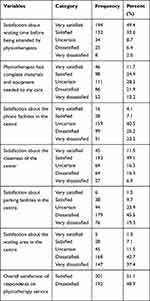 |
Table 5 Organization-Related Patient Satisfaction |
Factors Associated with Patients’ Satisfaction with Physiotherapy Service
Age, marital status, history of having heard about physiotherapy and feeling about physiotherapy were associated significantly with the dependent variable. The odds of satisfaction with physiotherapy service in patients older than 55 years was OR 1.78 (95% CI: 1.02–3.09; p = 0.04) times higher than in patients equal or younger than 55 years of age. The odds of satisfaction with physiotherapy service in patients who were married was OR 1.75 (95% CI:1.05–2.90; p = 0.03) times higher than in single patients, the odds of satisfaction with physiotherapy service in patients who have heard about physiotherapy before getting the service were OR 0.52 (95% CI: 0.31–0.87; p = 0.01) times less than from those who did not hear about physiotherapy service and the odds of satisfaction with physiotherapy service in patients having a good feeling about physiotherapy service was OR 3.76 (95% CI: 1.46–9.70; p = 0.006) times higher than those who had bad feeling (Table 6).
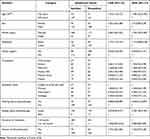 |
Table 6 Bivariate and Multivariate Analysis of Factors Associated with Patient’s Satisfaction |
Accordingly, age, marital status, history of hearing about physiotherapy before getting service, and feeling about physiotherapy service are significantly associated factors affecting patient satisfaction.
Discussion
In this study, almost half of the respondents were satisfied with the physiotherapy service given at the centers. This result is lower than studies done in Pakistan,1 Italy,4 Ghana18 and Nigeria.19 This might be due to accessibility of equipment and materials not being adequate to fulfill the unmet needs of the clients. Another reason might be that the study period was shorter than in Ghana and Nigeria which may mean that the respondents to a lesser extent have developed friendships with the physiotherapist and working staff of the center, which will again decrease the tendency of satisfaction. The other reason might be a difference in sample size, quality of service and socio-demographic characteristics of the respondents.
But the result is quite similar to a previous study done in Tigray, Mekelle, Ethiopia.6 This might be due to the fact that the health policy of Ethiopia still did not give more attention to physiotherapy service. This is evidenced by poor progression of the type of management and use of updated and modernized medical instruments in many physiotherapy centers.20 The other reason might be due to the study participants having almost similar socio-demographic characteristics.
In this study older age groups were more satisfied than young age groups. This result is supported by studies done in Sweden and in Asian countries.21,22 The result is consistent with studies done in Nigeria23 and Ghana.24 This might be because older patients may have lesser expectations of the services due to co-morbidity and increased utilization of health-care services.
Another variable which was statistically significant was marital status by which married respondents were more satisfied than single. The result is consistent with the studies done in Nigeria3 and Ghana.24 It is also consistent with studies done in Ethiopia.6 This might be because married people in this study have more stressful factors than single, where the married person who feels more stress relieved by the physiotherapeutic treatment in terms of physical and psychological context might have better satisfaction. This also might be due to married person have better financial, social and family support than singles.
The satisfaction of respondents who had heard about physiotherapy before getting the service was less than those who had not heard about physiotherapy. This might be because those patients who were familiar with physiotherapy before using the service and patients who are not well informed about the particular health service delivery might have higher clearly defined expectations and patients might not be satisfied when they felt that their care needs had been unmet. This is supported by studies done in the UK25 and Ghana.24
Finally, the satisfaction of respondents who had a good feeling about the physiotherapy service was higher than those who had a bad feeling. This might be because feeling better may help the patient have better improvement and achievement and will have a positive effect on patient satisfaction. The other reason might be patients might have lower expectations about the service they will get. This is supported by studies done in Canada, Switzerland and Norway.26–28
Limitation of the Study
A self-reported questionnaire used during data collection would tend to increase the chances of respondents’ over- or under-estimation of satisfaction. The study design does not to assess a cause-effect relationship.
Strength of the Study
Adequate sample size was used which enables a confident inference about the study participants, validated and internationally standardized tool for data collection was used and the study title itself was novel in Ethiopia.
Conclusion
Almost half of the respondents were satisfied with the physiotherapy service in a studied center in Ethiopia. Age, marital status, history of hearing about physiotherapy service and feelings about physiotherapy are significant factors affecting patient satisfaction in the physiotherapy service. More than half of the patients were dissatisfied with waiting area, equipment and materials available, parking facilities and phone facilities in the center.
Recommendation
As patient satisfaction is the fundamental concern in all health-care sectors and for all health-care professionals, patients’ feedback can be used scientifically in order to improve quality of health-care service. Based on the results of this study, we strongly recommend that health-care professionals do better to improve on informing the patient for better understanding and positive feeling about the physiotherapy service, health-care managers need to increase accessibility of the service with full availability of materials and equipment, and professionals throughout the country and finally researchers should investigate other factors affecting patient satisfaction on physiotherapy care.
Abbreviations
DMCSH, Debre Markos Comprehensive Specialized Hospital; FHCSH, Felege Hiwot Comprehensive Specialized Hospital; PT, physiotherapy; COR, crude odds ratio; AOR, adjusted odds ratio; CI, confidence interval; MRPS, MedRisk Instrument for Measuring Patient Satisfaction; PS, Patient Satisfaction.
Data Sharing Statement
The datasets used for this study are available from the corresponding author.
Ethical Consideration
Ethical clearance was obtained from research ethical committee of Debre Markos University, College of Health Science and from the physiotherapy unit of Debre Markos and Felege Hiwot Comprehensive Specialized Hospital. There were no ethical concerns when we were doing this research. Informed consent was taken from each respondent before data collection. Confidentiality of the information was kept throughout the study by excluding names and patient record numbers as identification in the data collection form and by ensuring the data was used only for this study. This study was done in accordance with the Declaration of Helsinki.
Acknowledgments
We acknowledge the DMCSH and FHCSH staff and managers for providing access to the data. We would like to express our deepest gratitude to all individuals for their indispensable contributions to this research work. We were also grateful to the data collectors and supervisors for carefully undertaking their tasks.
Author Contributions
All authors contributed to data analysis, drafting or revising the article, have agreed on the journal to which the article was submitted, gave final approval of the version to be published, and agree to be accountable for all aspects of the work.
Funding
There was no funding for this research.
Disclosure
Mr Girma Alem reports grants from Debre Markos University, during the conduct of the study. The authors declared no other potential conflicts of interest for this work, nor with respect to the research, authorship, or publication of this article.
References
1. Khan ML, Ghous M, Amjad I, Nouman M, Yaqoob I. Level of satisfaction regarding physical therapy services in district Poonch, Azad Jammu Kashmir. J Pak Med Assoc. 2020;70(3):452–456. doi:10.5455/JPMA.10977
2. Hush JM, Cameron K, Mackey M. Patient satisfaction with musculoskeletal physical therapy care: a systematic review. Phys Ther. 2011;91(1):25–36. doi:10.2522/ptj.20100061
3. Odumodu IJ, Olufunlayo TF, Ogunnowo BE, Kalu ME. Satisfaction with services among attendees of physiotherapy outpatient clinics in tertiary hospitals in Lagos State. J Patient Exp. 2020;7(4):468–478. doi:10.1177/2374373519847370
4. Rania N, Migliorini L, Vidili MG, Bianchetti P, Forno G, Cavanna D. Exploring well-being and satisfaction with physiotherapy efficacy: an Italian study of cancer patients. Mediterr J Clin Psychol. 2018;6:2.
5. Mahakalkar C, Kaple M, Jain N, Jaipuria P, Wagh D, Laddha P. Measuring patient satisfaction: a need of the day for tertiary care services. Int J Med Sci Public Health. 2015;4(5):658. doi:10.5455/ijmsph.2015.13122014135
6. Kutty RK, Gebremichael H, Tadesse K, Negash K, Teame B, Abraha M. Evaluation of patient’s satisfaction level and associated factors of physiotherapy services in mekelle ortho-physiotherapy centre, North Ethiopia: a Cross Sectional Study. IJPBSF. 2014;8(1):1.
7. Poulis I. Bioethics and Physiotherapy. Institute of Medical Ethics; 2007:435–436.
8. World Health Organization. World Report on Disability 2011. World Health Organization; 2011.
9. Casserley-Feeney SN, Phelan M, Duffy F, Roush S, Cairns MC, Hurley DA. Patient satisfaction with private physiotherapy for musculoskeletal pain. BMC Musculoskelet Disord. 2008;9(1):1–13. doi:10.1186/1471-2474-9-50
10. Olatunji T, Ogunlana M, Bello M, Omobaanu S. Assessment of patients satisfaction with physiotherapy care. J Nig Soc Physiother. 2008;16(1):11–15.
11. Medeiros F, Costa LOP, Oliveira N, Costa L. Satisfaction of patients receiving physiotherapy care for musculoskeletal conditions: a cross-sectional study. Fisioter Pesqui. 2016;23(1):105–110. doi:10.1590/1809-2950/14956323012016
12. World Health Organization. Summary: World Report on Disability 2011. World Health Organization; 2011:6099570705.
13. Gimigliano F, Negrini S. The World Health Organization “rehabilitation 2030: a call for action”. Eur J Phys Rehabil Med. 2017;53(2):155–168. doi:10.23736/S1973-9087.17.04746-3
14. Belay MM, Wamisho B, Gebre S. Doctor of physiotherapy program in Ethiopia. Asian J Sci Tech. 2017;8(1):4154–4160.
15. Forsythe DP. A new international committee of the red cross? J Hum Rights. 2018;17(5):533–549. doi:10.1080/14754835.2018.1536856
16. Beattie P, Turner C, Dowda M, Michener L, Nelson R. The MedRisk instrument for measuring patient satisfaction with physical therapy care: a psychometric analysis. J Orthop Sports Phys Ther. 2005;35(1):24–32. doi:10.2519/jospt.2005.35.1.24
17. Sadeq MM, Adib SM. Satisfaction with physiotherapy among patients at a general hospital in Kuwait. Saudi Med J. 2002;23(8):981–985.
18. Ampiah PK, Ahenkorah J, Karikari M. Patients’ satisfaction with inpatient orthopedic physiotherapy services at a Tertiary Hospital in Ghana. J Patient Exp. 2019;6(3):238–246. doi:10.1177/2374373518793144
19. Ojeniweh O, Popoola O, Adesina A, Mariere U, Rotifa S. Patient satisfaction with physical therapy care, in a tertiary healthcare facility: an evaluation of quality of physical therapy services provided in Federal Medical Centre, Yenagoa, Bayelsa State. 2021;3(2):116–117. doi:10.13140/RG.2.2.31742.10567
20. Footer CB, Tsegaye HS, Yitnagashaw TA, et al. Empowering the physiotherapy profession in Ethiopia through leadership development within the doctoring process. Front Public Health. 2017;5:51. doi:10.3389/fpubh.2017.00051
21. Tennakoon T, de Zoysa P. Patient satisfaction with physiotherapy services in an Asian country: a report from Sri Lanka. Hong Kong Physiother J. 2014;32(2):79–85. doi:10.1016/j.hkpj.2014.07.001
22. Rahmqvist M. Patient satisfaction in relation to age, health status and other background factors: a model for comparisons of care units. Int J Qual Health Care. 2001;13(5):385–390. doi:10.1093/intqhc/13.5.385
23. Rufa’i AA, Saidu IA, Lawan MD, et al. Outpatients’ satisfaction with the provision of physiotherapy services. Middle East J Rehabil Health. 2019;6(1):e69431.
24. Osei OG, Tieru DE, Omoniyi MM. Determinants of patients’ satisfaction with musculoskeletal dysfunction and stroke physiotherapy health care: community-based evidence. Afr J Health Sci. 2020;33(4):44–55.
25. Hills R, Kitchen S. Satisfaction with outpatient physiotherapy: a survey comparing the views of patients with acute and chronic musculoskeletal conditions. Physiother Theory Pract. 2007;23(1):21–36. doi:10.1080/09593980601147876
26. Normann B, Moe S, Salvesen R, Sørgaard KW. Patient satisfaction and perception of change following single physiotherapy consultations in a hospital’s outpatient clinic for people with multiple sclerosis. Physiother Theory Pract. 2012;28(2):108–118. doi:10.3109/09593985.2011.574782
27. Marks M, Herren DB, Vlieland TPV, Simmen BR, Angst F, Goldhahn J. Determinants of patient satisfaction after orthopedic interventions to the hand: a review of the literature. J Hand Ther. 2011;24(4):303–12. e10. doi:10.1016/j.jht.2011.04.004
28. Hudak PL, Hogg-Johnson S, Bombardier C, McKeever PD, Wright JG. Testing a new theory of patient satisfaction with treatment outcome. Med Care. 2004;726–739. doi:10.1097/01.mlr.0000132394.09032.81
 © 2021 The Author(s). This work is published and licensed by Dove Medical Press Limited. The full terms of this license are available at https://www.dovepress.com/terms.php and incorporate the Creative Commons Attribution - Non Commercial (unported, v3.0) License.
By accessing the work you hereby accept the Terms. Non-commercial uses of the work are permitted without any further permission from Dove Medical Press Limited, provided the work is properly attributed. For permission for commercial use of this work, please see paragraphs 4.2 and 5 of our Terms.
© 2021 The Author(s). This work is published and licensed by Dove Medical Press Limited. The full terms of this license are available at https://www.dovepress.com/terms.php and incorporate the Creative Commons Attribution - Non Commercial (unported, v3.0) License.
By accessing the work you hereby accept the Terms. Non-commercial uses of the work are permitted without any further permission from Dove Medical Press Limited, provided the work is properly attributed. For permission for commercial use of this work, please see paragraphs 4.2 and 5 of our Terms.
